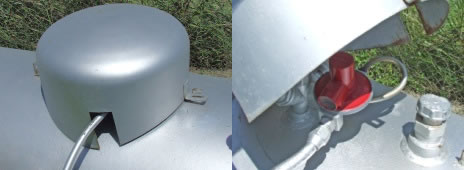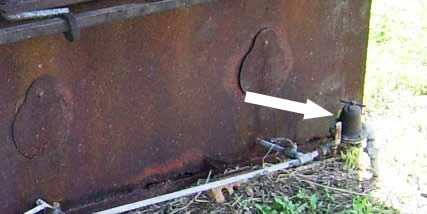Propane Regulator Installation

Propane regulator installation is a complicated process for those unfamiliar with LP Gas systems. The actual installation itself may be seem simple but there's a good bit more to the process than one might realize. Regulators are to be installed by LP Gas professionals only. Attempting to install a regulator yourself is dangerous and often illegal. This page will provide an understanding of what to look for in a regulator installation, not instructions on how to install a propane regulator.
LP Gas Tank Regulator Installation
All ASME propane tanks in service are required to have a regulator installed no more than 36 inches from the tank's service valve (see Regulator Connection). Regulators that are installed at the tank will be either a single stage regulator, high pressure regulator or integral two-stage regulator and must be protected from the elements by one of two means: 1) The regulator being shielded by means of a suitable cover such as the tank dome (pictured above) or 2) The regulator being installed with the vent facing down if installed without a cover. The underlying principle with regard to tank regulator installation is to protect the regulator's vent from anything that could enter through the vent.
Second Stage Regulator Installation

Second stage regulators are installed away from the tank, often on the outside wall of a building or near the propane gas appliance, such as an outdoor pool heater. The reason behind installing a second stage regulator involves efficiency and the economy of the installation. If high BTU demand appliances are located a good distance from the propane tank, the piping will have to be of a much larger diameter if an integral two stage regulator is installed, not to mention much more expensive. Downstream second stage regulators work in unison with first stage and high pressure regulators installed at the tank and allow for expansion of the gas system and future addition of LP Gas appliances.
Second stage regulators are easily spotted installed alongside a building (pictured left) with the yard line coming out of the ground into the inlet of the regulator and the regulator outlet connected to the piping that enters the building housing the LP gas appliances. Second stage regulators installed in this manner should have the vent pointed vertically down and at least 3 feet away from any building opening. See Two Stage Regulation for more information about second stage propane regulators
Regulator Protection From Heat
Installing a propane regulator near a source of heat is not only extremely unsafe, it is illegal. Regulators should be installed so that they are protected from sources of extreme heat. Regulator diaphragms are made of synthetic material and/or rubber and while they are designed to withstand certain amounts of heat, regulator diaphragms are not designed to withstand extremely high temperatures. Regulators have other internal components made of heat sensitive materials and although resistant to certain levels of heat, these regulator parts can be easily damaged by extreme heat and flame impingement. The installation of a propane regulator near a source of extreme heat (as pictured below) can cause the regulator to fail. Fires can be a result of a failed regulator due to extreme heat. Pictured here is an adjustable high pressure regulator that has been installed next to a metal cooking pit. The regulator has been exposed to such high temperatures that the paint has all been "baked" off. All high pressure regulators are red in color. This regulator is installed in an extremely unsafe manner.
Pictured here is an adjustable high pressure regulator that has been installed next to a metal cooking pit. The regulator has been exposed to such high temperatures that the paint has all been "baked" off. All high pressure regulators are red in color. This regulator is installed in an extremely unsafe manner.
